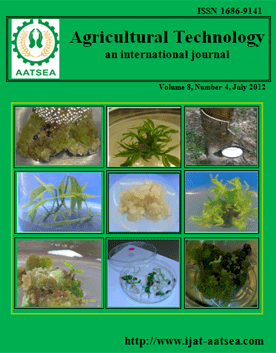ThaiScience
ThaiScience
INTERNATIONAL JOURNAL OF AGRICULTURAL TECHNOLOGY
Volume 14, No. 07, Month DECEMBER, Year 2018, Pages 2125 - 2136
Effects of tropical forage species on butyrivibrio fibrisolvens, fibrobacter succinogenes and total bacteria population in goat rumen using real-time pcr techniques
Thongruang S., Paengkoum, P., Suksombat, W. and Bureenok, S.
Abstract Download PDF
Three ruminally fistulated crossbred Saanen male goats (approximately 33 ± 3.0 kg BW) were used to determine the effect of 6 tropical forage diets on B. fibrisolvens, F. succinogenes and total bacteria population in goat rumen using real-time PCR techniques. The results showed that in grass experiment, three grass species including Purple Guinea (Panicum maximum TD58), Chinese Pennisetum (Pennisetum purpureum x Pennisetum alopecuroides) and Napier Pak Chong 1 (Pennisetum purpureum x Pennisetum americanum) were not significantly (p>0.05) different in the population of B. fibrisolvens (1.51-2.97 x 106 copies/ml), F. succinogenes (4.21-5.98 x 106 copies/ml) and total bacteria (4.08-6.58 x 1010 copies/ml) in goat rumen at 0, 2, 4 and 6 h after feeding. Similarly, legumes experiment, the population of ruminal B. fibrisolvens (1.31-3.01 x 106 copies/ml), F.succinogenes (4.01-5.73 x 106 copies/ml) and total bacteria (3.12-5.40 x 1010 copies/ml) of goats were not significantly (p>0.05) different between three legume species including Hamata (Stylosanthes hamate), Hedge Lucern (Desmanthus virgatus) and Leucaena (Leucaena leucocephala) at 0, 2, 4 and 6 h after feeding.
Keywords
forage species, Butyrivibrio fibrisolvens, Fibrobacter succinogenes, total bacteria, populationINTERNATIONAL JOURNAL OF AGRICULTURAL TECHNOLOGY
Published by : Association of Agricultural Technology in Southeast Asia (AATSEA)
Contributions welcome at : http://www.ijat-aatsea.com
